Application of Two Novel Acoustic Emission Parameters on Identifying the Instability of Granite
Abstract
:1. Introduction
2. Materials and Methodology
2.1. Sample Preparation
2.2. Experiment Apparatus and Procedure
2.3. Calculation Methodology of Information Entropy and Its CoV
2.4. Correlation Dimension Calculation Methodology
3. Results and Discussion
3.1. AE Amplitude Changes during the Loading Process
3.2. Relationship between the Information Entropy CoV and the Damage Process
3.3. Relationship between the Correlation Dimension and the Damage Process
4. Conclusions
- (1)
- Both the AE amplitude information entropy CoV and the correlation dimension curve under the triaxial loading state of the rock could accurately characterize the rock instability process.
- (2)
- According to the relation between the CoV of information entropy with the different stages of the loading process, the variation frequency of the information entropy increased during the loading process and then reached a plateau or slightly decreased before the rock failure. This phenomenon could be used as an indicator of rock instability.
- (3)
- Based on the changes in correlation dimension with the different stages of the loading process, it can be seen that each stage (the initial compaction stage, the linear elastic stage, the yield stage, and the failure stage) was well characterized by the correlation dimension. The starting point (D) or the bottom point (E) could be selected as the indicator point for the rock instability.
- (4)
- The method of combining the signals of information entropy CoV and correlation dimension could achieve a good results in identifying the precursor information of rock failure and instability.
Author Contributions
Funding
Institutional Review Board Statement
Informed Consent Statement
Data Availability Statement
Conflicts of Interest
References
- Brown, E. Risk assessment and management in underground rock engineering—An overview. J. Rock Mech. Geotech. Eng. 2012, 4, 193–204. [Google Scholar] [CrossRef] [Green Version]
- Goh, A.; Zhang, W. Reliability assessment of stability of underground rock caverns. Int. J. Rock Mech. Min. Sci. 2012, 55, 157–163. [Google Scholar] [CrossRef]
- Kong, X.; Wang, E.; He, X.; Zhao, E.; Zhao, C. Mechanical characteristics and dynamic damage evolution mechanism of coal samples in compressive loading experiments. Eng. Fract. Mech. 2019, 210, 160–169. [Google Scholar] [CrossRef]
- Xie, L.; Lu, W.; Zhang, Q.; Jiang, Q.; Wang, G.; Zhao, J. Damage evolution mechanisms of rock in deep tunnels induced by cut blasting. Tunn. Undergr. Space Technol. 2016, 58, 257–270. [Google Scholar] [CrossRef]
- Zhang, Y.; Zhao, G.; Li, Q. Acoustic emission uncovers thermal damage evolution of rock. Int. J. Rock Mech. Min. Sci. 2020, 132, 104388. [Google Scholar] [CrossRef]
- Nejati, H.; Ghazvinian, A. Brittleness effect on rock fatigue damage evolution. Rock Mech. Rock Eng. 2014, 47, 1839–1848. [Google Scholar] [CrossRef]
- Song, H.; Zhang, H.; Kang, Y.; Huang, G.; Fu, D.; Qu, C. Damage evolution study of sandstone by cyclic uniaxial test and digital image correlation. Tectonophysics 2013, 608, 1343–1348. [Google Scholar] [CrossRef]
- Zhou, X.; Zhang, J.; Yang, S.; Berto, F. Compression-induced crack initiation and growth in flawed rocks: A review. Fatigue Fract. Eng. Mater. Struct. 2021, 44, 1681–1707. [Google Scholar] [CrossRef]
- Cai, M.; Kaiser, P.K.; Tasaka, Y.; Maejima, T.; Morioka, H.; Minami, M. Generalized crack initiation and crack damage stress thresholds of brittle rock masses near underground excavations. Int. J. Rock Mech. Min. Sci. 2004, 41, 833–847. [Google Scholar] [CrossRef]
- Xue, D.; Gao, L.; Lu, L.; Zhou, J.; Zhou, H.; Wu, Z.; Yi, H.; Liu, J. An acoustic emission-based cluster damage model for simulating triaxial compression behaviors of granite. Rock Mech. Rock Eng. 2020, 53, 4201–4220. [Google Scholar] [CrossRef]
- Zhu, Z.; Tian, H.; Mei, G.; Jiang, G.; Dou, B.; Xiao, P. Experimental investigation on mechanical behaviors of Nanan granite after thermal treatment under conventional triaxial compression. Environ. Earth Sci. 2021, 80, 1–14. [Google Scholar] [CrossRef]
- Wu, F.; Chen, J.; Zou, Q. A nonlinear creep damage model for salt rock. Int. J. Damage Mech. 2019, 28, 758–771. [Google Scholar] [CrossRef]
- Feng, W.; Qiao, C.; Niu, S.; Yang, Z.; Wang, T. An improved nonlinear damage model of rocks considering initial damage and damage evolution. Int. J. Damage Mech. 2020, 29, 1117–1137. [Google Scholar] [CrossRef]
- Li, T.; Pei, X.; Wang, D.; Huang, R.; Tang, H. Nonlinear behavior and damage model for fractured rock under cyclic loading based on energy dissipation principle. Eng. Fract. Mech. 2019, 206, 330–341. [Google Scholar] [CrossRef]
- Ahmed, Z.; Wang, S.; Hashmi, M.Z.; Zhang, Z.; Zhu, C. Causes, characterization, damage models, and constitutive modes for rock damage analysis: A review. Arab. J. Geosci. 2020, 13, 1–14. [Google Scholar] [CrossRef]
- Gong, F.Q.; Si, X.F.; Li, X.B.; Wang, S.Y. Experimental Investigation of Strain Rockburst in Circular Caverns Under Deep Three-Dimensional High-Stress Conditions. Rock Mech. Rock Eng. 2018, 52, 1459–1474. [Google Scholar] [CrossRef]
- Hardy, H.R. Application of Acoustic Emission Techniques to Rock Mechanics Research. Chin. J. Sin. 1972, 505, 41–83. [Google Scholar]
- Koerner, R.M.; Mccabe, W.M.; Lord, A.E. Overview of acoustic emission monitoring of rock structures. Rock Mech. Rock Eng. 1981, 14, 27–35. [Google Scholar] [CrossRef]
- Li, D.; Miao, J. Acoustic emission and infrared characteristics of coal burst process. In Proceedings of the Controlling Seismic Hazard and Sustainable Development of Deep Mines, Dalian, China, 21–23 August 2009; Volume 2. [Google Scholar]
- Dick, G.J. Development of an Early Warning Time-of-Failure Analysis Methodology for Open Pit Mine Slopes Utilizing the Spatial Distribution of Ground-Based Radar Monitoring Data. Ph.D. Thesis, University of British Columbia, Vancouver, BC, Canada, 2013. [Google Scholar]
- Stanchits, S.; Desroches, J.; Burghardt, J.; Surdi, A.; Whitney, N. Rock fabric influence on hydraulic fracture propagation. In Proceedings of the 77th EAGE Conference and Exhibition 2015, Madrid, Spain, 1–4 June 2015; Volume 2015, pp. 1–5. [Google Scholar]
- Dong, L.; Tong, X.; Hu, Q.; Tao, Q. Empty region identification method and experimental verification for the two-dimensional complex structure—ScienceDirect. Int. J. Rock Mech. Min. Sci. 2021, 147, 104885. [Google Scholar] [CrossRef]
- Peng, K.; Zhou, J.; Zou, Q.; Zhang, Y.; Tan, G. Deformation characteristics and failure modes of sandstones under discontinuous multi-level cyclic loads. Powder Technol. 2020, 373, 599–613. [Google Scholar] [CrossRef]
- Xu, N.; Tang, C.A.; Hong, L.I.; Dai, F.; Ke, M.A.; Shao, J.D.; Wu, J. Excavation-induced microseismicity: Microseismic monitoring and numerical simulation. J. Zhejiang Univ. Ser. Appl. Phys. Eng. 2012, 13, 16. [Google Scholar]
- Liu, S.; Li, X.; Li, Z.; Chen, P.; Yang, X.; Liu, Y. Energy distribution and fractal characterization of acoustic emission (AE) during coal deformation and fracturing. Measurement 2019, 136, 122–131. [Google Scholar] [CrossRef]
- Zhao, X.G.; Cai, M.; Wang, J.; Ma, L.K. Damage stress and acoustic emission characteristics of the Beishan granite. Int. J. Rock Mech. Min. Sci. 2013, 64, 258–269. [Google Scholar] [CrossRef]
- Moradian, Z.; Einstein, H.H.; Ballivy, G. Detection of Cracking Levels in Brittle Rocks by Parametric Analysis of the Acoustic Emission Signals. Rock Mech. Rock Eng. 2016, 49, 785–800. [Google Scholar] [CrossRef]
- Dong, L.; Chen, Y.; Sun, D.; Zhang, Y. Implications for rock instability precursors and principal stress direction from rock acoustic experiments. J. Min. Sci. Technol. Engl. Ed. 2021, 31, 10. [Google Scholar] [CrossRef]
- He, M.; Zhao, F.; Cai, M.; Du, S. A novel experimental technique to simulate pillar burst in laboratory. Rock Mech. Rock Eng. 2015, 48, 1833–1848. [Google Scholar] [CrossRef]
- Wang, C.; Hou, X.; Liao, Z.; Chen, Z.; Lu, Z. Experimental investigation of predicting coal failure using acoustic emission energy and load-unload response ratio theory. J. Appl. Geophys. 2019, 161, 76–83. [Google Scholar] [CrossRef]
- Hao, H. Study on the Relationship between Rock Mechanical Properties and Fractal Dimension of Acoustic Emission. Ph.D. Thesis, Wuhan University of Technology, Wuhan, China, 2011. [Google Scholar]
- Xie, H.; Wang, J.; Kwaśniewski, M. Multifractal characterization of rock fracture surfaces. Int. J. Rock Mech. Min. Sci. 1999, 36, 19–27. [Google Scholar] [CrossRef]
- Xie, H.; Pariseau, W. Fractal character and mechanism of rock bursts. In Proceedings of the International Journal of Rock Mechanics and Mining Sciences & Geomechanics Abstracts; Elsevier: Amsterdam, The Netherlands, 1993; Volume 30, pp. 343–350. [Google Scholar]
- Qiao, P.; Cao, M. Waveform fractal dimension for mode shape-based damage identification of beam-type structures. Int. J. Solids Struct. 2008, 45, 5946–5961. [Google Scholar] [CrossRef] [Green Version]
- Li, S.; Lin, C.; Mao, J.; Huang, Y.; Hu, J. Experimental study on fractal dimension characteristics of acoustic emission of rock under multilevel uniaxial cyclic loading. Eng. Mech. 2015, 32, 92–99. [Google Scholar]
- Li, D.; Wang, E.; Kong, X.; Wang, X.; Zhang, C.; Jia, H.; Wang, H.; Qian, J. Fractal characteristics of acoustic emissions from coal under multi-stage true-triaxial compression. J. Geophys. Eng. 2018, 15, 2021–2032. [Google Scholar]
- Zhang, R.; Liu, J.; Sa, Z.; Wang, Z.; Lu, S.; Lv, Z. Fractal characteristics of acoustic emission of gas-bearing coal subjected to true triaxial loading. Measurement 2021, 169, 108349. [Google Scholar] [CrossRef]
- Gao, B.; Li, H.; Li, L.; Wang, X.; Yu, S. Study of acoustic emission and fractal characteristics of soft and hard coal samples with same group. Chin. J. Rock Mech. Eng. 2014, 33, 3498–3504. [Google Scholar]
- Chen, G.; Sun, X.; Wang, J.; Wang, D.; Zhu, Z. Detection of cracking behaviors in granite with open precut cracks by acoustic emission frequency spectrum analysis. Arab. J. Geosci. 2020, 13, 1–13. [Google Scholar] [CrossRef]
- Wang, C.; Cao, C.; Liu, Y.; Li, C.; Li, G.; Lu, H. Experimental investigation on synergetic prediction of rockburst using the dominant-frequency entropy of acoustic emission. Nat. Hazards 2021, 108, 3253–3270. [Google Scholar] [CrossRef]
- Ren, S.; Wang, L.; Xie, K.; Jiang, D.; Jiang, X. Experimental study on the critical characteristics of shale tension and compression failure based on acoustic emission counting information entropy. J. Chongqing Jiaotong Univ. Nat. Sci. Ed. 2020, 39, 7. [Google Scholar]
- Chen, L.; Liu, J.; Wang, C.; Liu, J.; Wang, J. Creep characteristics of Beishan granite under different temperature and stress states. Chin. J. Rock Mech. Eng. 2015, 34, 17. [Google Scholar]
- Verstrynge, E.; Schueremans, L.; Van Gemert, D.; Wevers, M. Monitoring and predicting masonry’s creep failure with the acoustic emission technique. NDT Int. 2009, 42, 518–523. [Google Scholar] [CrossRef] [Green Version]
- Shannon, C.E. A Mathematical Theory of Communication. Bell Syst. Tech. J. 1948, 27, 623–656. [Google Scholar] [CrossRef]
- Xu, C.; Ren, Q. Study on entropy mutation criterion for stability analysis of surrounding rock. Rock Soil Mech. 2004, 25, 102–105. [Google Scholar]
- Mandelbrot, B.B. Fractals: Form, Chance and Dimension; Freeman: San Francisco, CA, USA, 1977. [Google Scholar]
- Xie, H. Introduction to Fractals-Rock Mechanics; Science Press: Beijing, China, 1996. [Google Scholar]
- Hua, Z.; Ji, C. Fractal Theory and Its Applications; Science Press: Beijing, China, 2011. [Google Scholar]
- Sun, H.Q. Fractal Geometry and Fractal Interpolation; Science Press: Beijing, China, 2011. [Google Scholar]
- Grassberger, P.; Procaccia, I. Estimation of the Kolmogorov entropy from a chaotic signal. Phys. Rev. A 1983, 28, 2591. [Google Scholar] [CrossRef] [Green Version]
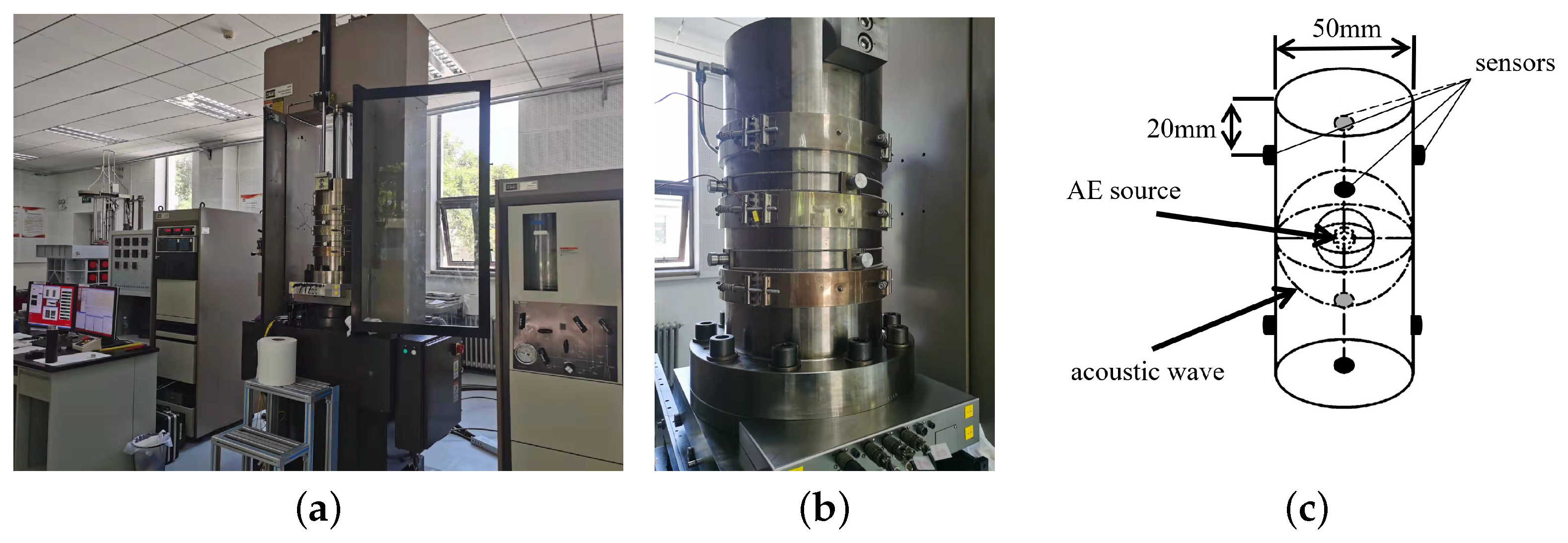
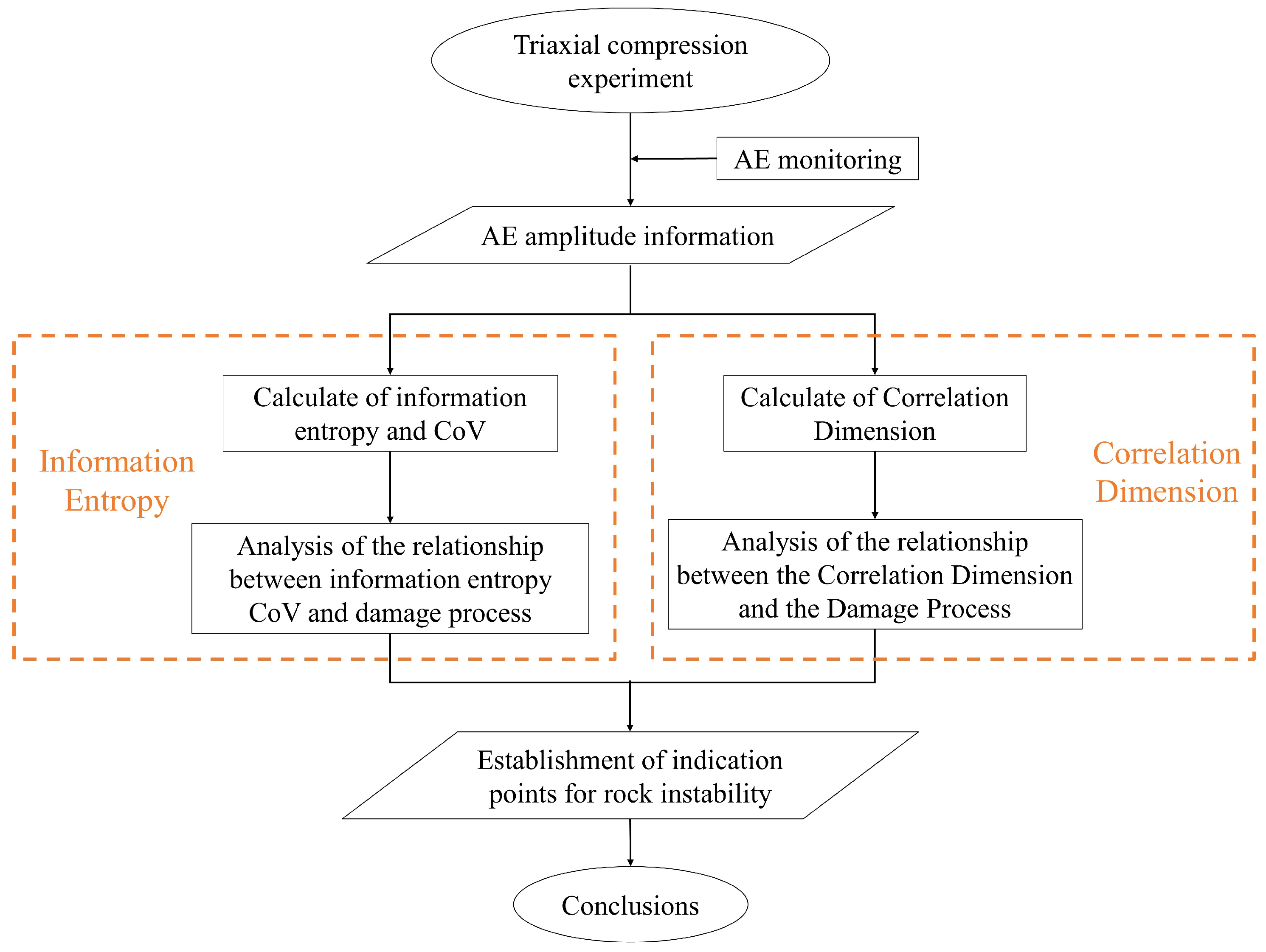
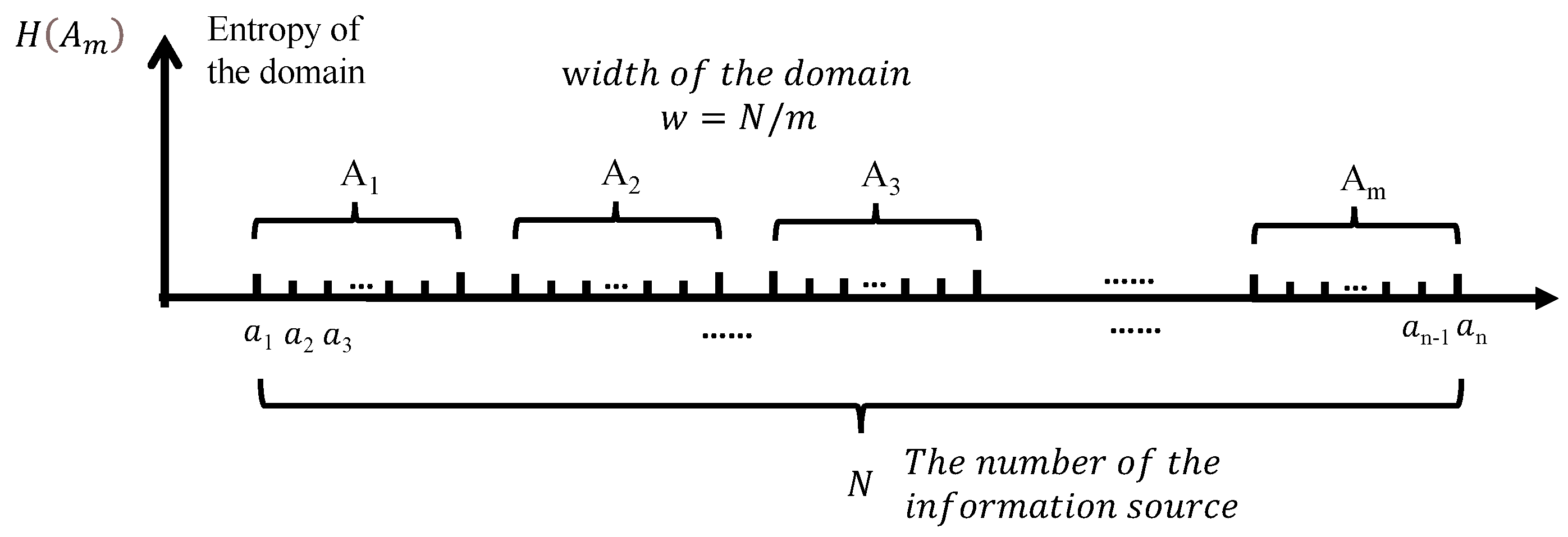
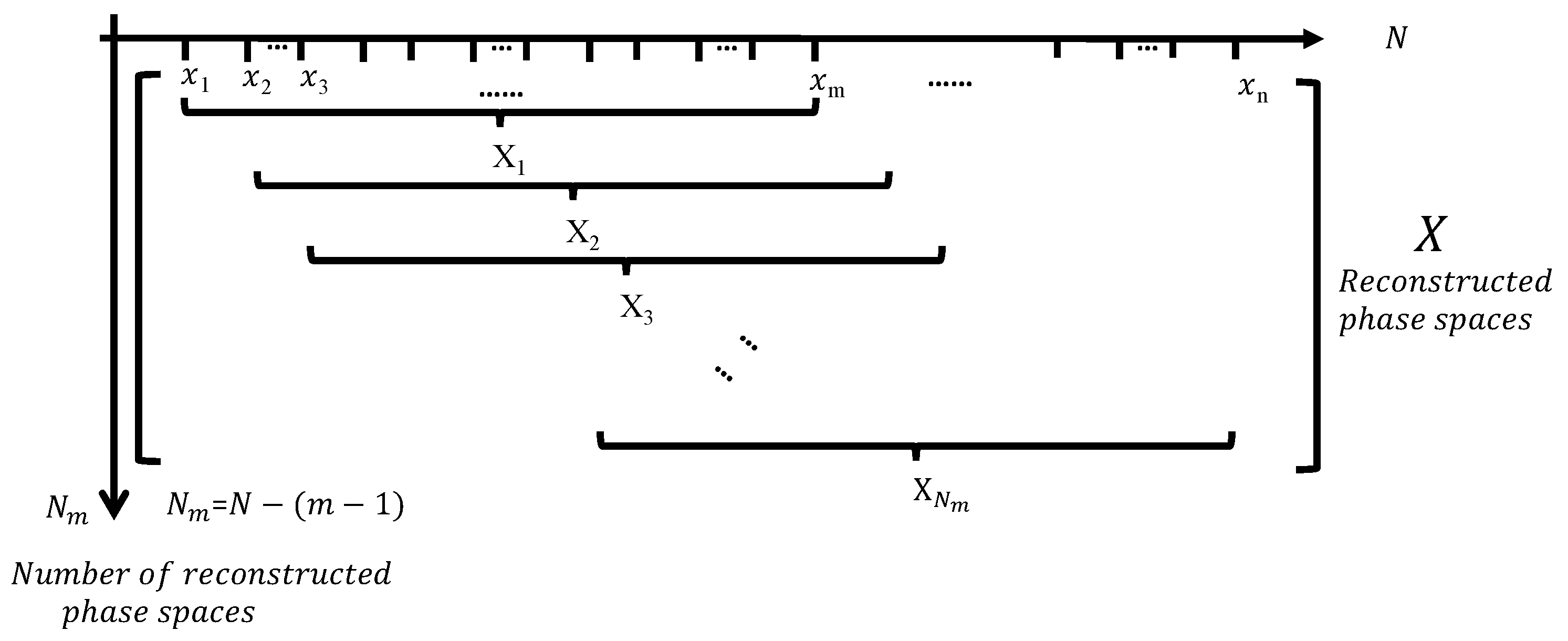
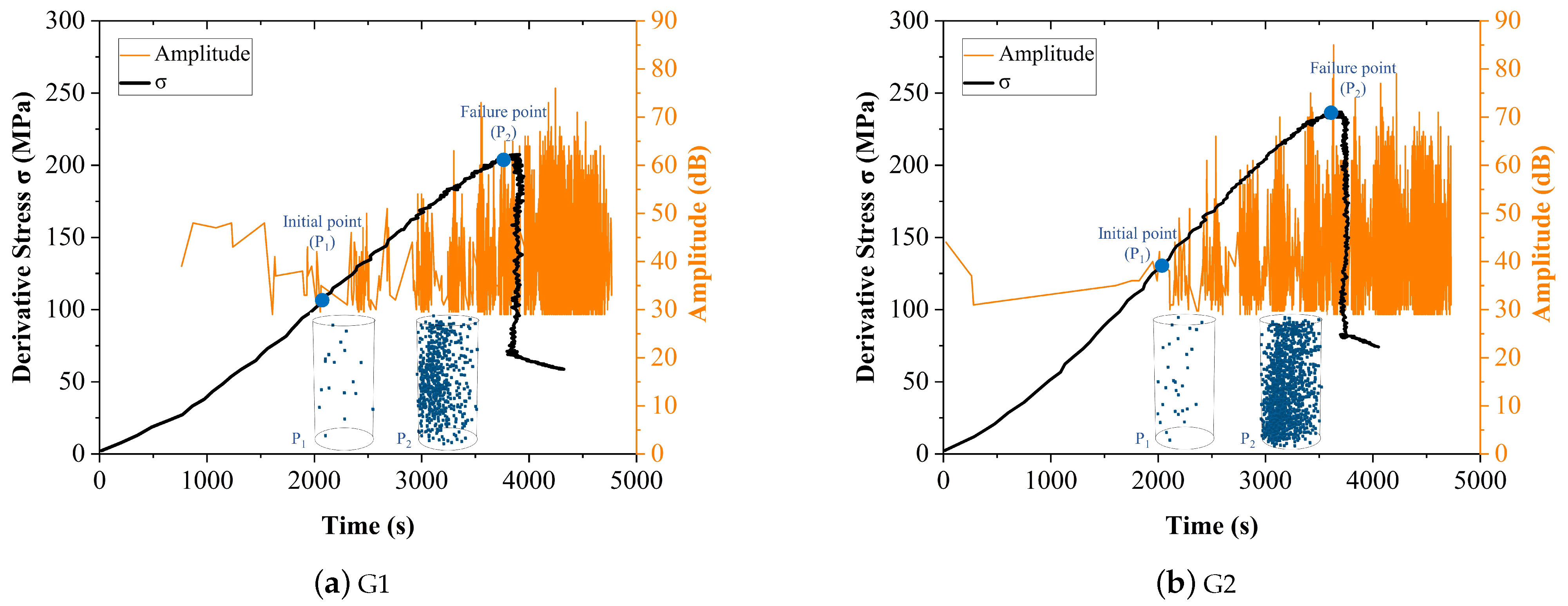
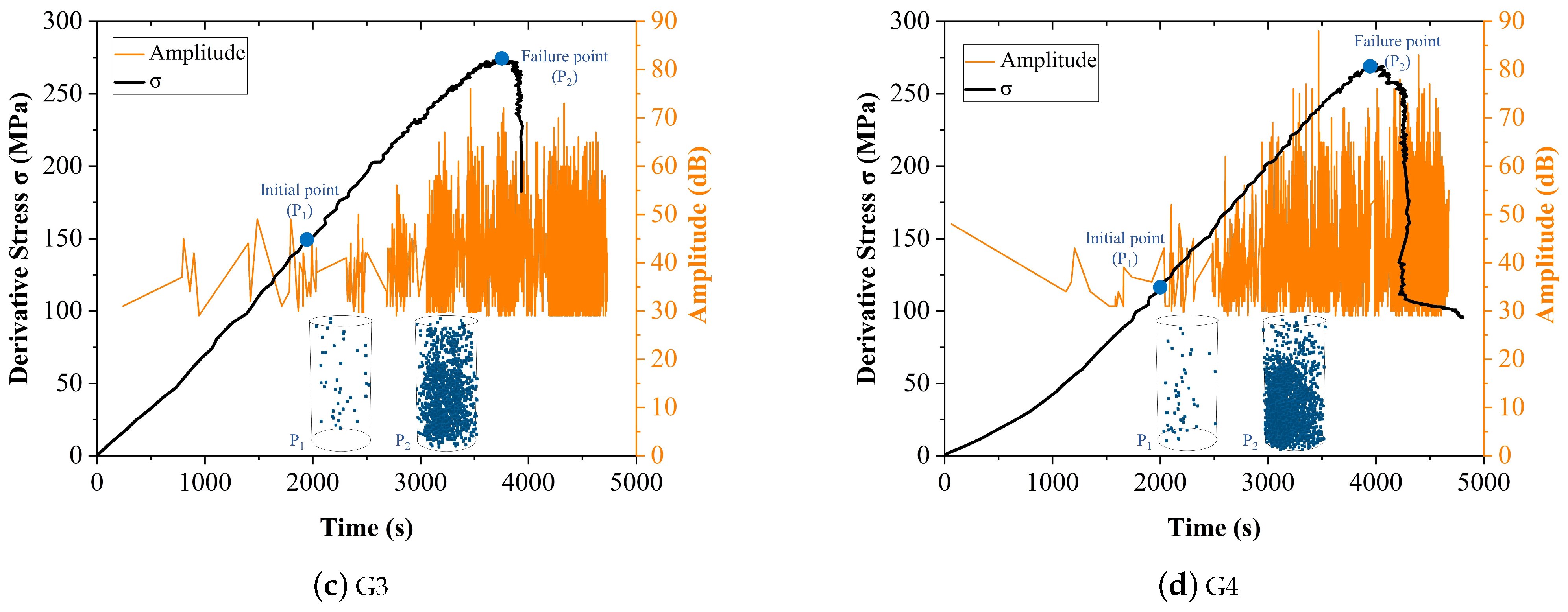
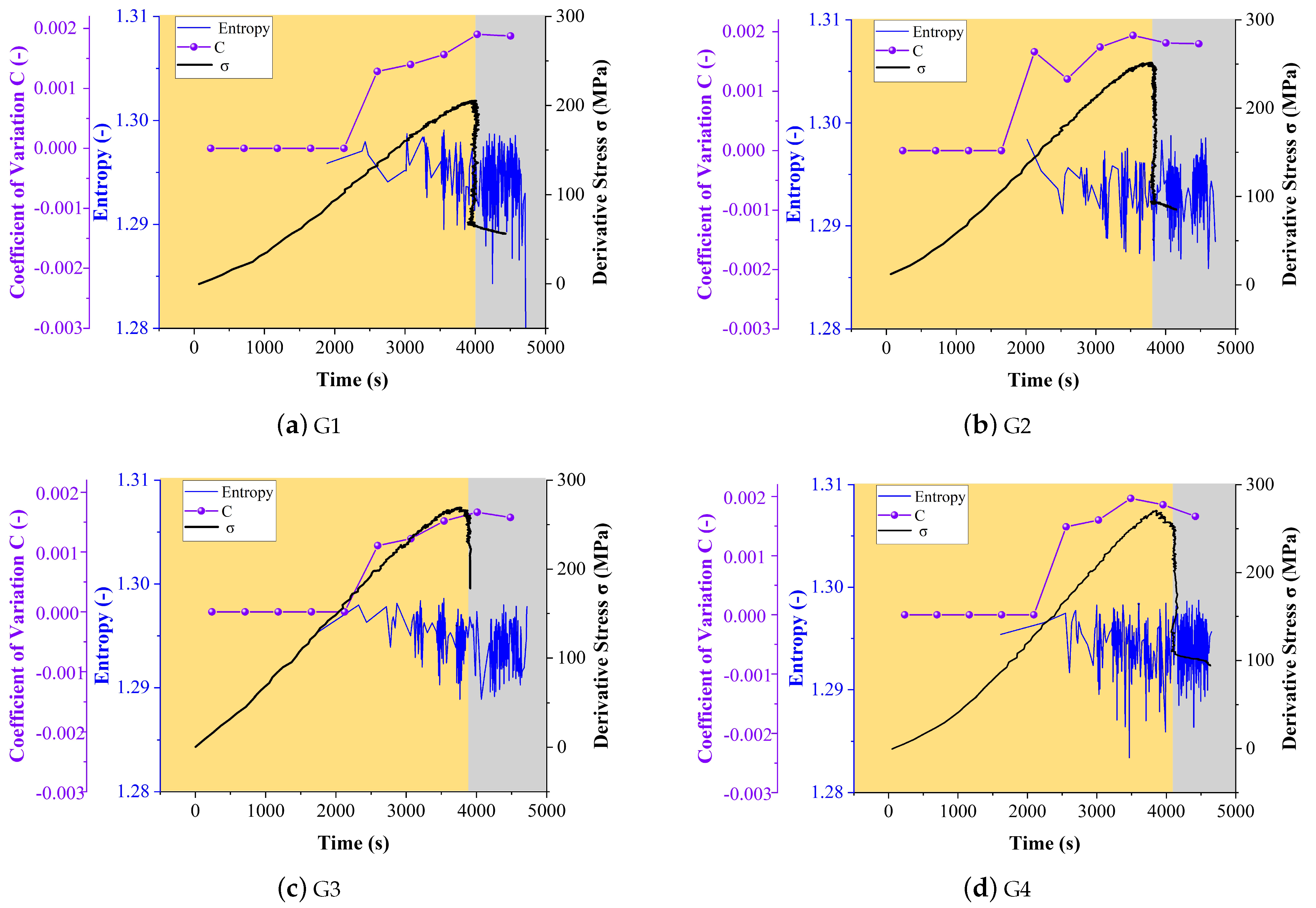

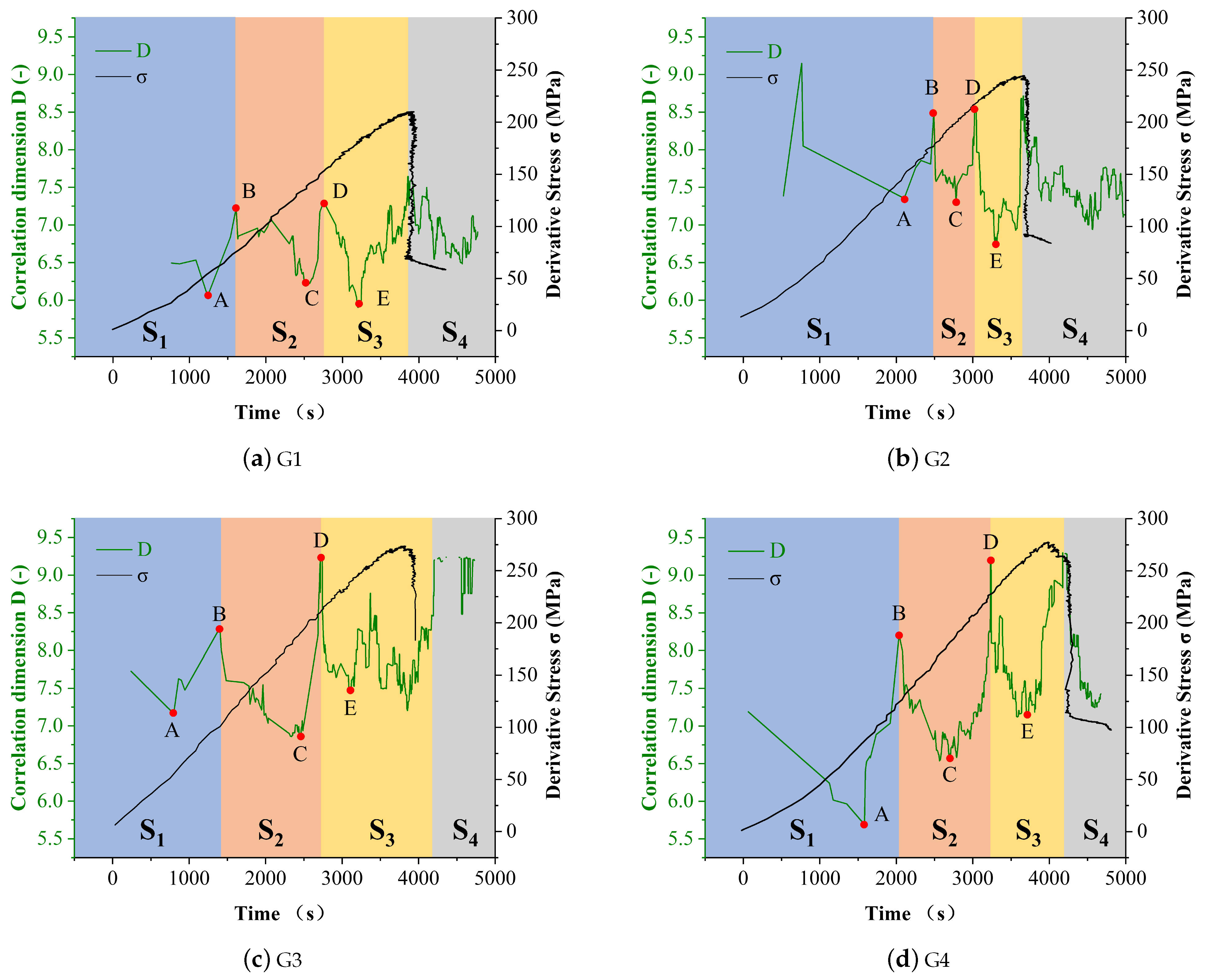
| Sample ID | Confining Pressure/MPa | Temperature/°C |
|---|---|---|
| G1 | 15 | 50 |
| G2 | 20 | 50 |
| G3 | 20 | 25 |
| G4 | 25 | 70 |
Publisher’s Note: MDPI stays neutral with regard to jurisdictional claims in published maps and institutional affiliations. |
© 2022 by the authors. Licensee MDPI, Basel, Switzerland. This article is an open access article distributed under the terms and conditions of the Creative Commons Attribution (CC BY) license (https://creativecommons.org/licenses/by/4.0/).
Share and Cite
Ji, Z.; Jiang, P.; Yi, H.; Zhuo, Z.; Li, C.; Wu, Z. Application of Two Novel Acoustic Emission Parameters on Identifying the Instability of Granite. Entropy 2022, 24, 750. https://doi.org/10.3390/e24060750
Ji Z, Jiang P, Yi H, Zhuo Z, Li C, Wu Z. Application of Two Novel Acoustic Emission Parameters on Identifying the Instability of Granite. Entropy. 2022; 24(6):750. https://doi.org/10.3390/e24060750
Chicago/Turabian StyleJi, Zhenxing, Peihua Jiang, Haiyang Yi, Zhuang Zhuo, Chunyuan Li, and Zhide Wu. 2022. "Application of Two Novel Acoustic Emission Parameters on Identifying the Instability of Granite" Entropy 24, no. 6: 750. https://doi.org/10.3390/e24060750
APA StyleJi, Z., Jiang, P., Yi, H., Zhuo, Z., Li, C., & Wu, Z. (2022). Application of Two Novel Acoustic Emission Parameters on Identifying the Instability of Granite. Entropy, 24(6), 750. https://doi.org/10.3390/e24060750






